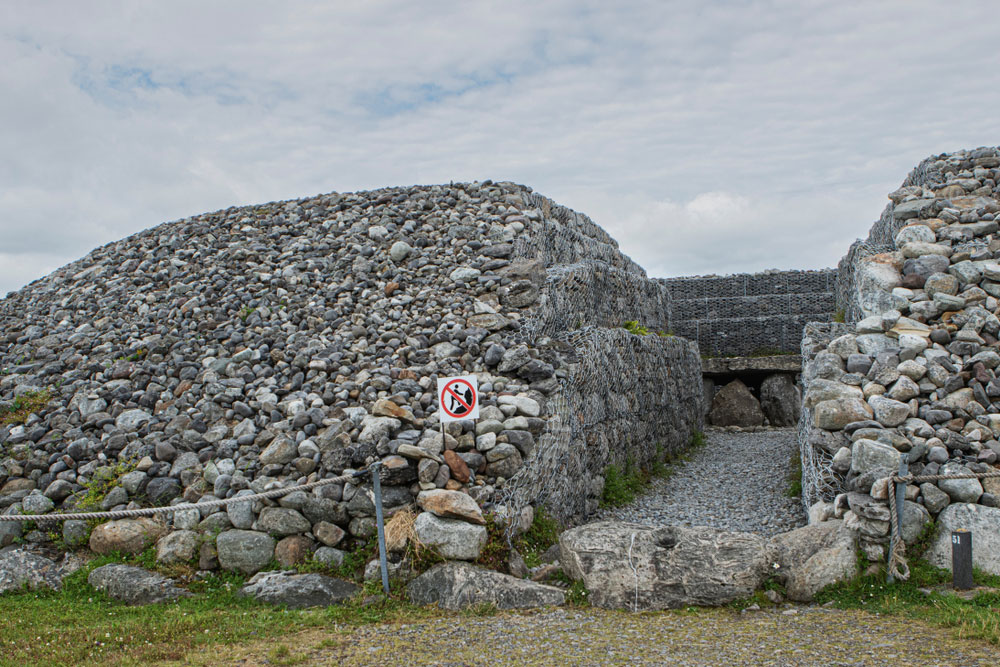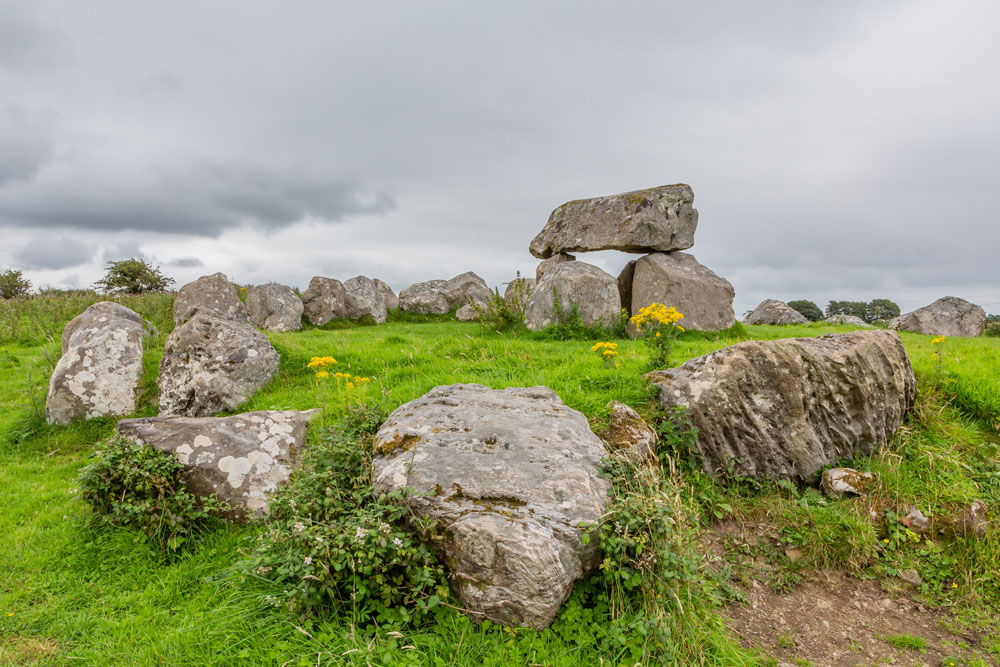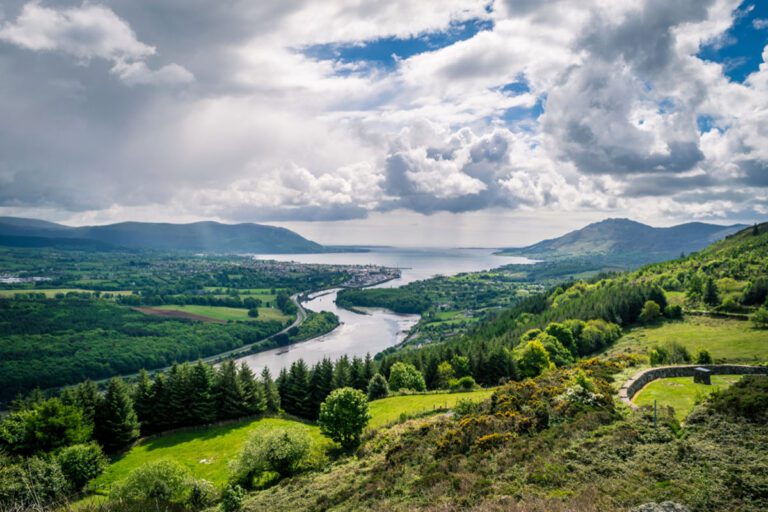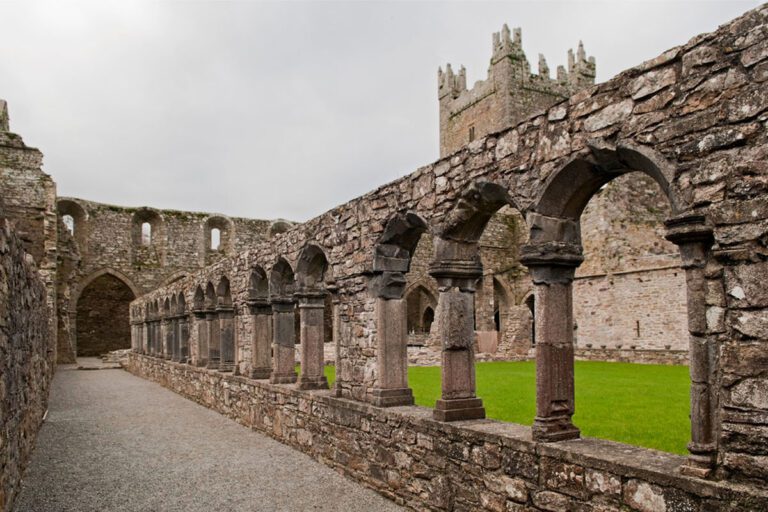Nestled within the enchanting landscapes of Ireland lies Carrowmore, a site veiled in mystery and antiquity. Carrowmore stands as a testament to the ancient history and spiritual practices of Ireland, housing an array of megalithic structures that have weathered the passage of time. Among these ancient structures are the remnants of a sacred burial ground, offering a glimpse into the rituals and lives of Ireland’s early inhabitants.
A Journey Through History
Embarking on a journey through Carrowmore is akin to stepping into a living chronicle of Ireland’s ancient past. Spanning over 5,000 years, this historic site stands as a time capsule, offering a rare glimpse into the lives and beliefs of Ireland’s earliest societies. As visitors traverse its sacred grounds, they’re greeted by an array of enigmatic structures that have weathered the ebb and flow of time, remaining steadfast in preserving the mysteries of antiquity.
Clusters of dolmens, stoic stone circles, and enigmatic passage tombs dot the landscape, each bearing testimony to an era steeped in reverence for both earthly and celestial realms. These ancient constructions, meticulously positioned and aligned with celestial events, bear testament to the profound astronomical knowledge possessed by the prehistoric inhabitants of this region.
The dolmens, standing tall and resolute, seem to echo stories of the past, while the stone circles, arranged in precise formations, evoke a sense of wonder and intrigue. These megalithic structures, believed to have been crafted with purpose and precision, are thought to have served ritualistic and cosmological functions, perhaps as celestial calendars or sites for spiritual ceremonies.
As the sun traverses the sky, casting shifting shadows and illuminating ancient stones, visitors can envision how these structures might have played a role in marking significant celestial events. The alignment of these megaliths with solstices, equinoxes, or other celestial phenomena suggests an intricate understanding of the cosmos, interwoven seamlessly with the daily lives and spiritual beliefs of these ancient communities.
Wandering through Carrowmore’s hallowed grounds, visitors are not merely observers but participants in an immersive odyssey through history. The whispers of the past linger among these weathered stones, inviting contemplation and fostering a deep appreciation for the cultural richness and spiritual depth of Ireland’s ancient civilizations.
Archaeological Wonders
The allure of Carrowmore transcends its mere physical presence; it’s an ancient tapestry woven with around 30 tombs, each bearing its unique story and adding to the enigmatic allure of this historic site. Among these tombs, the passage tombs take center stage, serving as remarkable architectural wonders that offer profound insights into the spiritual and cosmological beliefs of Ireland’s ancient communities.
The passage tombs, adorned with intricately carved stones and meticulously crafted structures, stand as testament to the craftsmanship and spiritual reverence of the builders. Carved with symbols and motifs, these stones portray an ancient language—one of celestial maps, symbolic representations, and perhaps even narratives of the lives lived and the rituals practiced by those who called Carrowmore home.
Stepping into these burial chambers is akin to stepping into a time capsule—an immersive experience where the shadows of the past dance along the walls, echoing whispers of ancient rituals and beliefs. The landscape itself serves as a canvas, with stones carefully positioned to align with celestial events, potentially marking significant moments in the annual cycle—a testament to a society deeply attuned to the rhythms of nature and the celestial spheres.
The layout and arrangement of these burial chambers hint at a society profoundly connected to the cosmos. The deliberate placement and alignment of stones may have served ceremonial, ritualistic, or even navigational purposes. These architectural marvels reflect not just the mastery of ancient engineering but also an intimate relationship with the celestial cycles, perhaps depicting the passage from life into the afterlife or the cosmic journey of the departed souls.
As visitors wander through this ancient cemetery, they are not just witnesses to an archaeological site but participants in an immersive journey through the beliefs, ideologies, and spiritual inclinations of Ireland’s ancient inhabitants. Carrowmore’s tombs, adorned with cryptic symbols and embedded within a landscape that reverberates with sacred significance, continue to beckon modern-day explorers, inviting them to unravel the mysteries of a bygone era.
Cultural Significance
Carrowmore, beyond its weathered stones and timeworn structures, stands as a testament to the very essence of Ireland’s ancient heritage—a cultural treasure trove that unveils the spiritual ethos and societal tapestry of prehistoric communities. These burial grounds, a repository of history and reverence, aren’t just silent stones but repositories of tales, beliefs, and the lives lived by those who once inhabited this sacred land.
Believed to cradle the remains of esteemed figures like chieftains, spiritual leaders, or revered individuals, Carrowmore’s burial grounds offer a poignant glimpse into the societal structure and the intricate belief systems that shaped ancient Irish communities. The deliberate positioning of these tombs and the careful arrangement of stones aren’t random; they speak of a deeply ingrained spiritual connection, an interplay between the earthly realm and the celestial heavens.
Amidst these weathered stones lie whispers of a society that perceived the cosmos not merely as distant stars but as an integral part of daily existence. The alignment of megaliths with astronomical phenomena—a celestial ballet choreographed by the ancients—hints at a profound understanding of the cosmos, intertwined with the fabric of their lives. Perhaps these alignments marked significant celestial events, serving as cosmic calendars or sites for spiritual ceremonies, reinforcing the symbiotic relationship between the people and the universe they inhabited.
The spiritual significance of Carrowmore transcends time, beckoning contemporary visitors to contemplate the depth of ancient wisdom. Stepping into this sacred realm isn’t just a historical excursion; it’s an immersive experience into the spiritual consciousness of a civilization deeply attuned to nature’s rhythms and the cosmic dance of stars. Carrowmore, with its ancient stones whispering tales of reverence and cosmic awareness, continues to be a window into the soul of Ireland’s ancient past—a legacy etched in stone and stars.

Preserving Ancient Heritage
The perpetuation and exploration of Carrowmore stand as pivotal endeavors in deciphering the enigmatic past of Ireland. Within these ancient stones and weathered monuments lies a narrative waiting to be unveiled—a tale of ancient lives, customs, and cultural heritage that continues to intrigue and captivate modern-day historians and archaeologists alike.
The ongoing archaeological endeavors at Carrowmore represent a harmonious blend of historical curiosity and technological innovation, seeking to unlock the secrets embedded in these ancient structures. This concerted effort harnesses the power of cutting-edge technology, ranging from advanced imaging techniques to meticulous excavation processes, all woven together with the threads of historical research and meticulous analysis.
The stones and tombs of Carrowmore are not static relics but living archives, concealing within them stories of societal structures, religious beliefs, and perhaps glimpses of daily life from a bygone era. Each excavation, each meticulous study, peels back layers of time, offering glimpses into the lives and rituals of those who once revered this land.
The comprehensive study of Carrowmore isn’t solely an academic pursuit; it’s a collective homage to the ancient souls interred here—an endeavor to honor their legacy by preserving and comprehending the cultural tapestry they wove. It’s an invitation to traverse the corridors of time, guided by technology and historical insights, to bridge the gap between the ancient past and the present.
Through these endeavors, the modern world is offered a portal—a window into a world veiled by millennia—immersing us in the rich heritage of Ireland’s prehistoric communities. Carrowmore remains not just an archaeological site but an evocative tableau where the whispers of antiquity converge with the technological marvels of today, allowing us to weave together the threads of an ancient narrative and preserve the legacy of those who came before us.
Visiting Carrowmore
Embarking on a pilgrimage to Carrowmore is far more than a casual tourist excursion—it’s an immersive odyssey that transcends temporal boundaries, inviting visitors to traverse the corridors of time and steep themselves in Ireland’s ancient legacy. As one steps onto this hallowed ground, a profound sense of connection to an age long past permeates the air.
The journey through Carrowmore is akin to navigating a living museum, where the artifacts are not encased in glass but weathered by the passage of millennia. Visitors meander through this ethereal landscape, surrounded by the enigmatic aura of ancient stones and the weight of historical significance that saturates the air.
The atmospheric setting at Carrowmore evokes contemplation and curiosity, beckoning visitors to decipher the secrets whispered by the weathered monoliths. Amidst this serene ambiance, one can’t help but ponder the lives lived, rituals practiced, and beliefs upheld by the ancient inhabitants who once walked these grounds.
Every step taken on this sacred soil is a step into the past—a chance to commune with history, feel the echoes of an ancient society, and behold the remnants of a culture that reverberates through time. Visitors are not merely observers but participants in a captivating narrative woven by the stones, each step guiding them through the annals of an ancient civilization.
The experience at Carrowmore isn’t solely about witnessing an archaeological site; it’s an invitation to immerse oneself in a bygone era, to listen intently to the echoes of antiquity, and to marvel at the enduring legacy left behind by Ireland’s ancestors. It’s a voyage through history, inviting us to glean wisdom from the past and carry it forward into the future.
Here are some more famous tourist attractions in County Sligo:
- Benbulbin: A distinctive flat-topped mountain, offering scenic hikes and breathtaking views.
- Yeats Society and Yeats Memorial Building: Celebrates the life and works of renowned poet W.B. Yeats.
- Lissadell House and Gardens: A historic estate with gardens, offering tours of its heritage and stunning surroundings.
- Sligo Abbey: A medieval abbey with well-preserved ruins and architectural beauty.
- Strandhill Beach: A popular spot for surfing and beach walks along the Atlantic coast.
- Rosses Point: Picturesque coastal village offering stunning views, beaches, and golfing opportunities.
- Knocknarea: A hill known for the massive cairn atop it, reputed to be the burial site of the legendary Queen Maeve.
- Eagles Flying: An interactive raptor center offering bird of prey demonstrations and educational experiences.
- Sligo Folk Park: Showcases rural life and traditional crafts, giving insights into Irish heritage.
Helpful Resources:




